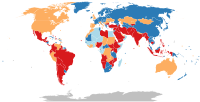
Photo from wikipedia
The coronavirus pandemic has disrupted clinical practice, healthcare organizations, and life. In the context that “a crisis is a terrible thing to waste,” as disruptive as the pandemic has been… Click to show full abstract
The coronavirus pandemic has disrupted clinical practice, healthcare organizations, and life. In the context that “a crisis is a terrible thing to waste,” as disruptive as the pandemic has been to traditional practices – both clinically and educationally – opportunities have also presented. Clinical benefits have included the propulsion of clinical innovation, including development of novel vaccines; accelerated understanding of multiplex ventilation, etc. Approaches to educating students and other learners have also changed radically, with suspension of live teaching in most instances and a precipitous transition to virtual instruction. This perspective considers a SWOT analysis (strengths, weaknesses, opportunities, and threats) associated with the coronavirus pandemic in healthcare, focusing on the implications for education. While the obvious disadvantages (weaknesses) regard the loss of face-to-face interaction with all of its consequences, e.g., isolation, risks to camaraderie, loss of hands-on training opportunities, and loss of in-person celebratory events like graduations and end-of-training celebrations, there are clearly offsetting strengths. These include growing experience with virtual teaching and virtual learning strategies; the invitation to codify best virtual teaching practices; a tightening of alignment between undergraduate and graduate medical education, e.g., around virtual interview strategies; and opportunities both for self-reflection and a commitment to act virtuously. On balance, the pandemic has created the opportunity – indeed the necessity – to innovate in practice and in education, making the landscape ripe for creative practice, new mastery, and the concomitant benefits to learners and to educators.
Journal Title: Chest
Year Published: 2020
Link to full text (if available)
Share on Social Media: Sign Up to like & get
recommendations!